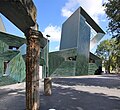
Mainz is the capital and largest city of the German state of Rhineland-Palatinate, and with around 223,000 inhabitants, it is Germany's 35th-largest city. It lies in the Rhine-Main Metropolitan Region—Germany's second-largest metropolitan region after Rhine-Ruhr—which also encompasses the cities of Frankfurt am Main, Wiesbaden, Darmstadt, Offenbach am Main, and Hanau.

Rhineland-Palatinate is a western state of Germany. It covers 19,846 km2 (7,663 sq mi) and has about 4.05 million residents. It is the ninth largest and sixth most populous of the sixteen states. Mainz is the capital and largest city. Other cities are Ludwigshafen am Rhein, Koblenz, Trier, Kaiserslautern, Worms, and Neuwied. It is bordered by North Rhine-Westphalia, Saarland, Baden-Württemberg and Hesse and by France, Luxembourg and Belgium.
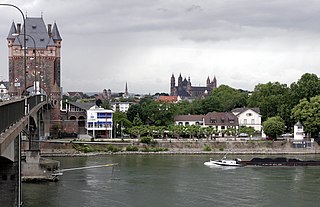
Worms is a city in Rhineland-Palatinate, Germany, situated on the Upper Rhine about 60 km (40 mi) south-southwest of Frankfurt am Main. It had about 84,646 inhabitants as of 2022.

Roonstrasse Synagogue is an Orthodox Jewish congregation and synagogue, located at 50 Roonstraße in Cologne, Germany. The synagogue is the only surviving of the five synagogues of Cologne before the Nazi era.
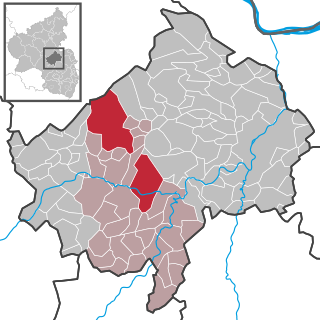
Bad Sobernheim is a town in the Bad Kreuznach district in Rhineland-Palatinate, Germany. It belongs to the like-named Verbandsgemeinde, and is also its seat. It is a state-recognized spa town, and is well known for two fossil discovery sites and for the naturopath Emanuel Felke. Bad Sobernheim is also a winegrowing town.

Hennweiler is an Ortsgemeinde – a municipality belonging to a Verbandsgemeinde, a kind of collective municipality – in the Bad Kreuznach district in Rhineland-Palatinate, Germany. It belongs to the Verbandsgemeinde Kirner Land, whose seat is in the town of Kirn.

Monzingen is an Ortsgemeinde – a municipality belonging to a Verbandsgemeinde, a kind of collective municipality – in the Bad Kreuznach district in Rhineland-Palatinate, Germany. It belongs to the Verbandsgemeinde of Nahe-Glan, whose seat is in the like-named town. Monzingen is a more than 1,200-year-old winegrowing village and a state-recognized recreational resort (Erholungsort).

Lindenschied is an Ortsgemeinde – a municipality belonging to a Verbandsgemeinde, a kind of collective municipality – in the Rhein-Hunsrück-Kreis (district) in Rhineland-Palatinate, Germany. It belongs to the Verbandsgemeinde of Kirchberg, whose seat is in the like-named town.

The Königsberg Synagogue, called at the time, the New Synagogue, was a former Orthodox Jewish congregation and synagogue, located in Königsberg in Prussia, East Prussia, Germany.

The Worms Synagogue, also known as Rashi Shul, is a Jewish congregation and synagogue located in the northern part of the city center of Worms, in the Rhineland-Palatinate region of Germany.
Manuel Herz is an architect with his own practice in Basel, Switzerland and Cologne, Germany.
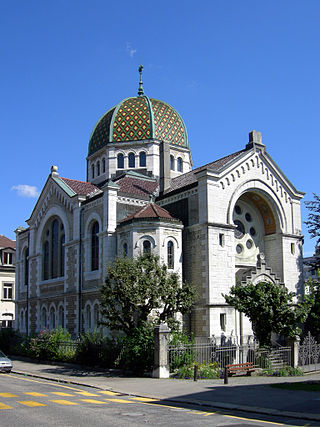
The Synagogue of La Chaux-de-Fonds is a Jewish congregation and synagogue, located at 63 Rue du Parc, in La Chaux-de-Fonds, in the Canton of Neuchâtel, Switzerland.
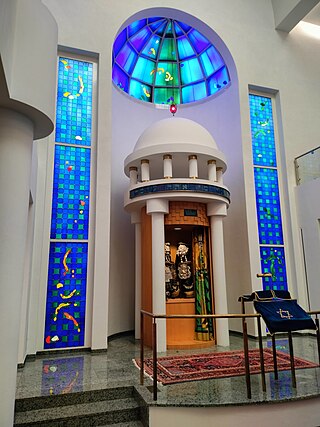
The New Synagogue is a Reform Jewish congregation, synagogue, community centre, and Jewish museum, located in Darmstadt, in the state of Hessen, Germany.

The Wittlich Synagogue is a former Jewish congregation and synagogue, located on Himmeroder Straße 44, in Wittlich, in the state of Rhineland-Palatinate, Germany. Designed by Johannes Vieknen in the Art Nouveau style and completed in 1910, the synagogue was the main place of worship for the city's Ashkenazi Jewish community until 1938.

The Roxheim Synagogue was a Jewish congregation and synagogue, that was located on Bobenheimer Strasse in Roxheim, in the state of Rhineland-Palatinate, Germany. The synagogue was built in 1889 in, Germany. The unrestored stone building was located and was demolished in 2017.

The Fraenkelufer Synagogue is a Conservative congregation and synagogue located on Kottbusser Ufer 48–50, today's Fraenkelufer 10-16, in the Kreuzberg district of Berlin, Germany.

Anne Spiegel is a German politician of Alliance 90/The Greens. She served as Federal Minister for Family Affairs, Senior Citizens, Women and Youth in the cabinet of Chancellor Olaf Scholz since 8 December 2021; she announced her resignation on 11 April and was dismissed by the President on 25 April 2022

Michael Hartmann is a German politician and member of the Social Democratic Party of Germany (SPD). He was a member of the German Bundestag from 2002 to 2017. Hartmann is a specialist politician for internal security and was the domestic policy spokesman of the SPD parliamentary group as well as the chairman of his parliamentary group in the Committee on Internal Affairs and a member of the Parliamentary Oversight Panel.

The Synagogue of Sulzbach is a former Jewish congregation and synagogue located in the town of Sulzbach-Rosenberg, in Bavaria, Germany. Built in 1822 on the site of two earlier synagogues, the building was abandoned in 1930, and was subsequently repurposed as a private residence form the 1950s, and returned to the Jewish community for use as a Jewish museum and community center since 2013.

The Jewish Community of Mainz had significance throughout Europe in the High Middle Ages, was destroyed several times, and has re-emerged even after the Holocaust.


